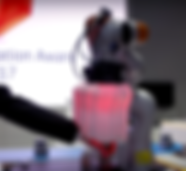
Prof. Dr.-Ing.
H A N N E S
H Ö P P N E R
PROFESSOR FOR HUMANOID ROBOTICS
Berliner Hochschule für Technik
Profile

I am Professor for Humanoid Robotics at Berliner Hochschule für Technik (BHT) since October 2019. I am the head of the Soft Interactive Robotics Laboratory (SIRo-Lab), which is currently being developed by Steffen Puhlmann and me. The goal of this lab is to explore topics of (1) Soft-Robotic Hand Design and Manipulation, (2) Soft-Robotic Materials and Mechanism Design, and (3) Human-Robot-Interaction for elderly care. In the bachelor's degree program Humanoid Robotics at BHT, I mainly teach subjects related to mechanical design, manufacturing and maintenance of robotic systems, as well as human-robot interaction. Additionally, I am laboratory manager of the teaching laboratory for Humanoid Robotics at BHT. From 2018 to 2019 I was group leader of sports technology development at the Institute of Applied Training Science IAT in Leipzig. At IAT I mainly focused on the development and application of automatic joint tracking methods and automatic following via drones for athletes, as well as sport specific measurement setups. Between 2009 and 2018, I was scientific researcher at the German Aerospace Center (DLR) – Institute of Robotics and Mechatronics. In 2016, under the supervision of Patrick van der Smagt and Veit Senner, I received my PhD from the Technical University of Munich on the topic of "Analysis of human intrinsic stiffness modulation and its use in variable-stiffness robots". I was organization chair of the “Summer School on Impedance” in 2011 and the "Summer School on Soft Manipulation" in 2017 on Frauenchiemsee, Germany. My main research interests include design and application of soft robotic hands, the development of continuous and perturbation-based methods for measuring intrinsic human hand and arm characteristics, the tele-operation of it to robotic systems and the design of variable stiffness actuators for robotic arms and hands. Moreover, I focused on the development of a safety system for safe human-robot collaboration and won the KUKA Innovation Award 2017. Between 2015 and 2018 I was principle investigator at DLR for the EU project soma and won together with my colleagues the DLR Idea Award 2018 for the development of a novel soft robotic hand.
Teaching
"Robotics Project" @ BHT
2nd semester students from the Humanoid Robotics Bachelor’s program at Berliner Hochschule für Technik (BHT) are challenged to demonstrate their skills in the Robotics Project which is supervised by Mario Weidner, Steffen Puhlmann and me.
In groups of four, they are given the task to develop a robotic hand from scratch. Connected to the Panda robot arm from Franka Emika, these hands are tasked to pick up a selected set of objects from a flat table surface and to place them at a distance. Possible objects are a business card, a slice of toast, a net of limes, a wooden plate, an ice cream cone, and a paper cup.
Each group is provided with five Dynamixel servo motors from ROBOTIS (Robot is ...) together with the necessary electronics, and a coupling to mount the hand to the Panda arm. Thanks to its simple graphical user interface, this arm can already be used by novice users. For developing their hands, students use various processes of additive manufacturing, laser cutting, vacuum thermoforming, and casting of polyurethane in custom-designed molds. To control the hands, a custom Python API is provided allowing, for example, to close the fingers until contact.
The results are always impressive. While all hands are cable-driven, many of them have the ability to actively oppose their thumb, while some hands are even equipped with two thumbs. Hats off to this amazing performance of the students!
In the Press
Robotic Airbag
-
Bloomberg.com "This Company Has a Way to Make Robots Safer for Humans"
-
The Detroit News "Airbags can protect workers from robots"
-
Engineering.com "What’s New in End Effectors: Higher Payload, Faster Speed and Better Safety"
-
Digitaltrends.com "Cars have airbags, so why shouldn’t your robot co-worker?"
-
The Verge "Robot airbags could help industrial bots play nice with humans"
-
IEEE Spectrum Robotics "Video Friday: Robots With Airbags, Drone vs. Drone, and MIT's Jumping Cube"
-
ZDNET.com "Video of man getting beaned by robot demonstrates need for novel safety mechanisms"
-
MIT Technology Review "How Can You Stop Robots From Injuring Workers? Perhaps with Airbags"
-
Automobil Produktion "DLR überrascht mit Airbag für Cobots"
-
springwise.com "Airbag for robots eliminates risk to co-working humans"
-
Insurance Journal "How One German Company Is Making Workplace Robots Safer for Humans"
DLR Humanoid David
Projects (excerpt)
Goal: Soft Manipulation (soma) opens a path of disruptive innovation for the development of simple and compliant, yet strong, robust and easy-to-program manipulation systems. The soma EU project explored a new avenue of robotic
manipulation in real environments, exploiting the physical constraints imposed by the environment to enable robust grasping and manipulation in dynamic, open, and highly variable contexts. New Soft Hands were designed for the versatile and competent exploitation of Environmental Constraints, and the development of robust, cost-effective, and safe robotic grasping and manipulation capabilities.
My role at DLR: project lead at DLR, analyzing the role of co-contraction for human grip biomechanics [Hoeppner2017], development of soft robotic hands [Friedl2018], tele-operating soft robotic hands in real-world scenarios [Haas2018]
Partners: Technische Universität Berlin (coord.), Universita di Pisa, Fondazione Istituto Italiano di Tecnologia, Institute of Science and Technology Austria, German Aerospace Center (DLR), and more
Duration: 05/2015 - 04/2019
THE (Grant no. 248587)
Goal: The scientific goals of the EU project The Hand Embodied concerned the reciprocal linkages between the physical hand and its high-level control functions, and about the way that the embodiment enables and determines its behaviors and cognitive functions. The idea was to study how the embodied characteristics of the human hand affect and determine the learning and control strategies people use for such fundamental cognitive functions as exploring, grasping and manipulating. The ultimate goal of the project was to learn from human data how to devise improved system architectures for the hand as a cognitive organ, and eventually how to better design and control robot hands, haptic interfaces and hand prostheses.
My role at DLR: Developing devices for measuring intrinsic human hand properties continuously [Hoeppner2013], developing and investigating feedback systems for feeding back grip forces of prosthetic hands into the toe (this resulted in the following work [Hagengruber2017], [Hagengruber2018])
Partners: Università di Pisa (coord.), German Aerospace Center (DLR), National Technical University Athens, niversità di Siena, Utrecht Universiteit, Vrije Universiteit Amsterdam, Université Pierre et Marie Curie Paris, Lunds Universitet, Swedish ICT AB, Universität Bielefeld, Arizona State University
Duration: 03/2010 - 05/2014
Goal: The goal of the EU project VIACTORS was to develop robots that can safely work and interact with humans. This was achieved by using the concept of Variable Impedance Actuation and by understanding the physical and biological principles of human motion and safety. The project aimed to create a new generation of robot actuators with similar properties as the human neuro-mechanical system. The project outcomes were evaluated through robotic manipulation, bipedal locomotion, and rehabilitation robots, using existing prototypes from partner labs.
My role at DLR: Developing variable stiffness actuators for humanoid robotic arms [Friedl2011], [Grebenstein2011], [Vanderborght2013], [Petit2014], [Wolf2015]
Partners: University of Pisa, University of Twente, Imperial College London, Italian Institute of Technology, Free University of Brussels, German Aerospace Center (DLR, coord.)
Duration: 02/2009 - 01/2012
STIFF (Grant no. 231576)
Goal: The EU project STIFF project aimed at creating a versatile robot hand-arm system by mimicking the human motor system. It accomplished this by modeling and measuring the human arm and hand, and developing methods to understand impedance adaptation. The project used robot manipulators and machine learning to acquire grasp force and muscle activity
activity data, which were then applied to the robotic system. The goal was to optimize the biomorphic robot's variable impedance through techniques validated on the biophysical model.
My role at DLR: Developing devices for measuring intrinsic human hand and arm properties continuously [Hoeppner2011], [Hoeppner2013]
Partners: Delft University of Technology, IDSIA Switzerland, Paris Descartes University, University of Edinburgh, German Aerospace Center (DLR, coord.)
Duration: 01/2009 - 12/2011
2022
2020
2018
2017
2016
2015
2014
2013
2011
Patents (excerpt)

Höppner, H.:
DE102015202179 B4, 15.12.2016,
Deutsches Zentrum für Luft- und Raumfahrt e.V.

Höppner, H, Friedl, W.:
DE102016209639 A1, 02.06.2016,
Deutsches Zentrum für Luft- und Raumfahrt e.V., zur Prüfung

Höppner, H., Vogel, J.:
WO2017158120 A1, 17.03.2016,
Deutsches Zentrum für Luft- und Raumfahrt e.V., zur Prüfung
DE102016201540 A1, 02.02.2016,
Deutsches Zentrum für Luft- und Raumfahrt e.V., zur Prüfung
DE102015202179 B4, 15.12.2016,
Deutsches Zentrum für Luft- und Raumfahrt e.V.
Höppner, H., Weitschat, R.:
Höppner, H., Vogel, J., Weitschat, R.:
DE102016101235A1
DE102017108618 A1,
21.04.2017,
Deutsches Zentrum für Luft- und Raumfahrt e.V., zur Prüfung

Höppner, H., Vogel, J.:

Höppner, H., Vogel, J.:
DE102016107250 A1,
22.04.2015,
Deutsches Zentrum für Luft- und Raumfahrt e.V., zur Prüfung

Höppner, H.,
van der Smagt, P.:
DE102010014895 B4, 13.02.2014,
Deutsches Zentrum für Luft- und Raumfahrt e.V.

Höppner, H.:
DE102012214094 B3, 14.08.2013,
Deutsches Zentrum für Luft- und Raumfahrt e.V.

Höppner, H., Weitschat, R.:
DE102017108618 A1,
21. 04. 2017,
Deutsches Zentrum für Luft- und Raumfahrt e.V., zur Prüfung
Supervised Theses (excerpt)
Master & Diploma Theses
-
Mark Haas (2017, Master Thesis, Hochschule Kempten / DLR): Untersuchung menschlicher Griffsteifigkeit zur Teleoperation einer weichen Roboterhand
-
Annette Hagengruber (2017, Master Thesis, FH Oberösterreich / DLR): Analysis of Humans Capability to Discriminate Multidimensional Forces at the Big Toe
-
Zijin Yu (2015, Master Thesis, EPFL / DLR): Dynamical estimation of human arm stiffness in context of sEMG based teleoperation
-
Van Cao Phan (2014, Master Thesis, TU Dortmund / DLR): Multi-dimensional teleoperation using EMG based impedance control with force feedback
-
Maximilian Große-Dunker (2013, Master Thesis, Hochschule München / DLR): Untersuchung des Zusammenhangs von Fingerkinematik, Fingersteifigkeit und Muskelaktivität
-
Bardia Shahbaz (2011, Diploma Thesis, TU Dresden / DLR): Entwicklung eines haptischen Feedback-Geräts zur Reinnervation von 3D-Kräften in den menschlichen Zeh
Bachelor Theses
-
Lion Weber (2022, Berliner Hochschule für Technik / SIRo-Lab): Programmable Morphological Computation for Improved Grasping and Manipulation
-
Erik Schlenzka (2022, Berliner Hochschule für Technik / SIRo-Lab): Sensing Spring Deformation for Pose Estimation of Intrinsically Compliant Tendon-Driven Robotic Finger
-
Florentin Marquardt (2022, Berliner Hochschule für Technik / SIRo-Lab): Development and Evaluation of an Experimental Setup for Visual Pose Estimation of Anthropomorphic Robot Fingers
-
Larissa Quaschning (2022, Berliner Hochschule für Technik / Gestalt Robotics): Untersuchung von Möglichkeiten der Sensordatenfusion bei der Navigation von mobilen Robotern
-
Alicia Schildhauer (2021, Berliner Hochschule für Technik / Honda Research Institute EU): Human-robot cooperation for solving a manipulation task in the context of outpatient elderly care
-
Wolfgang Wiedmeyer (2013, TU München / DLR): Dynamische Simulation eines biartikulären Antriebssystems mit variabler Steifigkeit


























